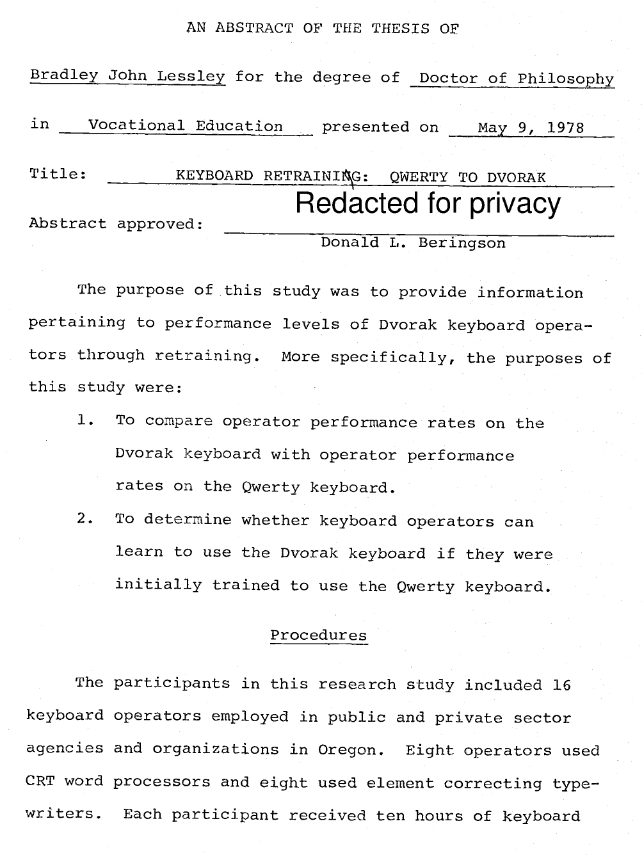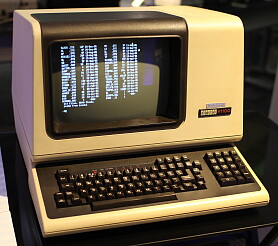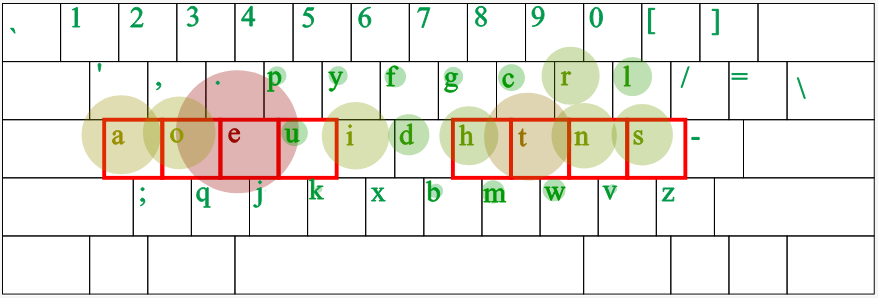Qwerty to Dvorak, A PhD thesis, 1978
Xah's Review

- Keyboard Retraining: Qwerty to Dvorak
- A PhD thesis by Bradley John Lessley, 1978
- https://ir.library.oregonstate.edu/concern/graduate_thesis_or_dissertations/8336h4796
This article is not of much value today, except historical.
In a very hard-to-read and wordy way, it tries to answer the question, about whether for people already know how to touch-type QWERTY, how long would it take them to learn Dvorak, and if their speed would improve.
The conclusion of the article is that, after 100 hours of retraining, yes, the speed improvement may be 12 to 17 percent. (see page 66.)
Note, if you train 1 hour per day, then 100 hours would be 3 months.
The article has significant historical value though. It was written in 1978.
to give a sense of what typing is like in 1978, here's 2 popular computers at the time.
Note, the screen can only show 80 x 40 characters.
The article, gave summarization of about 8 previous research studies. Also, their conclusion is similar to the article.
Keyboard Retraining: Qwerty to Dvorak
A PhD thesis by Bradley John Lessley, 1978
Abstract
The purpose of this study was to provide information pertaining to performance levels of Dvorak keyboard operators through retraining. More specifically, the purposes of this study were:
1. To compare operator performance rates on the Dvorak keyboard with operator performance rates on the Qwerty keyboard.
2. To determine whether keyboard operators can learn to use the Dvorak keyboard if they were initially trained to use the Qwerty keyboard.
Procedures:
The participants in this research study included 16 keyboard operators employed in public and private sector agencies and organizations in Oregon. Eight operators used CRT word processors and eight used element correcting typewriters. Each participant received ten hours of keyboard introduction instruction on the Dvorak keyboard, followed by 100 hours of skill-development keyboarding involving both skill-development drill exercise and daily office production correspondence.
Nine null hypotheses were developed regarding Dvorak keyboard retraining rates.
The t test and one- and two-factor analysis of variance with repeated measures were used to test these null hypotheses. Trend analysis was also used to describe the data.
Conclusions:
1. Dvorak keyboard production and straight-copy rates, after 100 hours of skill-development keyboarding, were not significantly greater than preretraining Qwerty keyboard production and straight-copy rates for both CRT and element keyboarding equipment. The learning curve slopes, however, were still upward at the end of 100 hours of skill-development keyboarding, suggesting that production and straight-copy learning would continue on both types of keyboarding equipment.
2. Dvorak keyboard production rates were found to be significantly different at 20- and 25-hour intervals for CRT and element keyboarding equipment, respectively, for 100 hours of skill-development keyboarding. The same was found for combined CRT/element Dvorak keyboard straight-copy rates at ten-hour intervals.
3. The Dvorak keyboard production rate of learning on both types of equipment was found to be linear for 100 hours of skill-development keyboarding.
The Dvorak keyboard straight-copy rate was found to be curvilinear. Production rates were not combined as they were for straight-copy performance, since different performance measures were used with each type of keyboard equipment.
 ADM-3A Terminal
ADM-3A Terminal DEC VT100 Terminal
DEC VT100 Terminal Dvorak Layout
Dvorak Layout